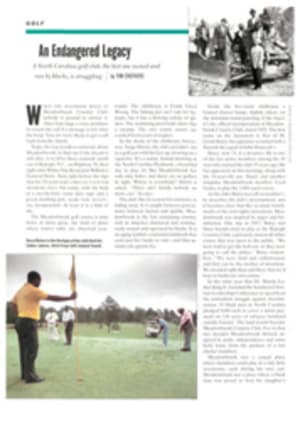
Recycling Abandoned Railroads
What on earth was Franco Harris doing on an abandoned railroad right-of-way in western Pennsylvania with all those bicycles? Why wasn't the nine-time Pro Bowl player, four-time Super Bowl winner and fifth-highest alltime NFL rushing leader kicking back, as one might expect, with, say, Lynn Swann, his longtime pal from the Steelers? "Hey, I think it's a great idea," says Harris of the old railway. "I'm a big believer in cities having a place for people to go to ride their bikes, and when I heard about this, I said I'd be there."
Harris is talking about a nationwide network of recreational trails built on deserted railroad lines, and he is particularly enthusiastic about such paths because he owns the Pittsburgh Power, a professional cycling team. On Oct. 4, Harris led a five-mile walk to observe the Butler-Freeport Trail's grand opening, part of the celebration commemorating the 500th railroad right-of-way (the Minuteman Trail, outside Boston) to be converted into a trail.
Like Harris, Peter Harnik, an environmental administrator from Washington, D.C., and an avid cyclist himself, has long had an interest in establishing community bike paths free from automobiles and exhaust fumes. So he was intrigued when, in 1981, he learned that such a path had recently opened just outside Washington along an old railroad bed. A few years later, in 1985, Harnik and others formed a committee to explore developing such paths across the country. And that was the beginning of the Rails-to-Trails Conservancy (RTC), which took as its model that first segment of the Washington and Old Dominion Trail, a 45-mile route that begins in northern Virginia and heads west to the foothills of the Blue Ridge Mountains. Seven years later, the RTC has a staff of 19 in its Washington headquarters, and trails in 44 states are under its aegis.
Run by Harnik and a former lawyer for the National Wildlife Federation, David Burwell, the RTC advises communities on the logistics of converting and maintaining rail trails for bikers, hikers, runners and skiers. After the Interstate Commerce Commission—the agency that regulates rail travel—has officially declared a railroad abandoned, citizen groups or local governments may obtain the rights to turn the railroad into a trail. The RTC lets trail advocates and state or local governments know of upcoming abandonments, and it helps interested groups secure the rights to the railroads. Once a community's claim to the railroad has been recognized, rails and ties are removed from the railbed and scrapped, and the long, narrow corridors are paved with asphalt, crushed stone or wood chips. The length of the trails varies, the longest being the 200-mile Katy Trail, which runs through Missouri. Because trains can't crawl up steep slopes or race down sharp inclines, the trails' grades are fairly flat, making them perfect for exercise by older folks or wheelchair users.
Above all, the trails are meant to offer a convenient and inexpensive escape. "People just can't afford to go to Yosemite anymore," says Harnik. "With two wage earners for so many families, people don't have the time and they don't necessarily have the money to take long vacations. They are looking for a park experience that's close to home, one they can do on weekends and can do with small children or older people."
The idea of rail trails is not new. Wisconsin's Elroy Sparta State Park Trail and the Illinois Prairie Path have been around since the mid-1960s. The Elroy Sparta is free to hikers. Snowmobilers and cyclists, who pay a registration fee and a nominal charge, respectively, can zip along a 32-mile trail that features three stone tunnels well over 100 years old. The Elroy Sparta drew 68,500 people last year.
Some trails, such as Pennsylvania's Ghost Town Trail, wind back through local history. Others offer users an abundance of wildlife. The Old Savannah/Tybee Railroad Trail, in Georgia, winds around the South Channel and Savannah rivers and is bordered by palm trees, marshland and small islands, providing access to ideal fishing holes. Canoeists and kayakers enjoy weaving through old canals, and dolphins can be spotted in the South Channel River.
For more information, write to the Rails-to-Trails Conservancy at 1400 16th Street, NW, Suite 300, Washington, D.C. 20036.
PHOTO
SCOTT GOLDSMITH
A Steeler's wheels: Harris and friend Dave Eaton hit the trail.
Lori Nickel is an intern with The Milwaukee Journal.

